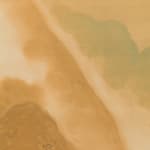Nishimura Seiki 西村青歸
Image size each 73½ x 33½ inches (186.8 x 85.2 cm)
Further images
-
(View a larger image of thumbnail 1
)

-
(View a larger image of thumbnail 2
)

-
(View a larger image of thumbnail 3
)

-
(View a larger image of thumbnail 4
)

-
(View a larger image of thumbnail 5
)

-
(View a larger image of thumbnail 6
)

-
(View a larger image of thumbnail 7
)

-
(View a larger image of thumbnail 8
)

-
(View a larger image of thumbnail 9
)

-
(View a larger image of thumbnail 10
)

-
(View a larger image of thumbnail 11
)

-
(View a larger image of thumbnail 12
)

-
(View a larger image of thumbnail 13
)

-
(View a larger image of thumbnail 14
)

Each panel signed and sealed (respectively at lower left and upper right) Seiki 青帰 with a seal Ki 帰
Exhibited in the Bunten National Exhibition of 1917
Born in Osaka in 1883 with the birth name Kizaburō 喜三郎, Nishimura Seiki graduated from Tokyo School of Art in 1906 and became a pupil of Terasaki Kōgyō (1866–1919). He exhibited three times at the Bunten National Exhibition, in 1911, 1913 (prizewinner), and 1917 (the present painting); participated in the revival of the Nihon Bijutsuin (Japan Art Institute) in 1914; exhibited at the special exhibition in commemoration of Prince Shōtoku (1926); and instructed the famous painter and printmaker Itō Shinsui (1898-1972).
Nishimura Seiki’s early emphasis on figure subjects reflected the influence of his teacher Terasaki Kōgyō, but during his mature period he gravitated toward pure landscape with a preference for autumnal scenes in mountain settings where human figures play a subsidiary (but significant) role, as with the tiny figure by the mountain stream in the left-hand panel. Nishimura exploits to the full the rich, warm tones of the mineral pigments and shell gesso that characterize painting in the neo-nativist Nihonga manner, achieving an atmospheric blend of traditional East Asian compositional techniques with touches of Western perspective and impressionistic brushwork, enlivened by expressive use of color.
Other published works exhibited in the Bunten National Exhibitions and published in the Nittenshi:
Dōtonbori, depicting a boating scene in downtown Osaka, set in the Edo period
Published: Nittenshi 2, Tokyo, 1980, no. 63 (pp. 215, 250)
Kyorai (Coming and Going), pair of two-panel folding screens depicting a figure beneath a tree in fall
Fumoto no aki (Fall in the foothills), an agricultural scene
Both published: Nittenshi 3, Tokyo, 1980, nos. 51, 52 (pp. 42, 107, 108)
Exhibitions
Eleventh Bunten Exhibition, Tokyo, fall 1917
Publications
Other Published Works:
Dōtonbori, depicting a boating scene in downtown Osaka, set in the Edo period (1615–1868)
Nittenshi Hensan Iinkai 日展史編纂委員会 (Nittenshi Editorial Committee), Nittenshi 2 日展史 2 (History of the National Salon 2), Bunten hen 2 文展編二 (The Bunten Exhibition, Part 2), Tokyo, Nitten 日展, 1980, no. 63 (pp. 215, 250)
Kyorai (Coming and Going), pair of two-panel folding screens depicting a figure beneath a tree in fall; Fumoto no aki (Fall in the foothills), an agricultural scene
Nittenshi Hensan Iinkai 日展史編纂委員会 (Nittenshi Editorial Committee), Nittenshi 3日展史 3 (History of the National Salon 3), Bunten hen 3 文展編三 (The Bunten Exhibition, Part 3), Tokyo, Nitten 日展, 1980, nos. 51, 52 (pp. 42, 107, 108)
Nittenshi Hensan Iinkai 日展史編纂委員会 (Nittenshi Editorial Committee), Nittenshi 5 日展史 5 (History of the National Salon 5), Bunten hen 5 文展編五 (The Bunten Exhibition, Part 5), Tokyo, Nitten 日展, 1981, no. 105 (pp. 34, 98)













